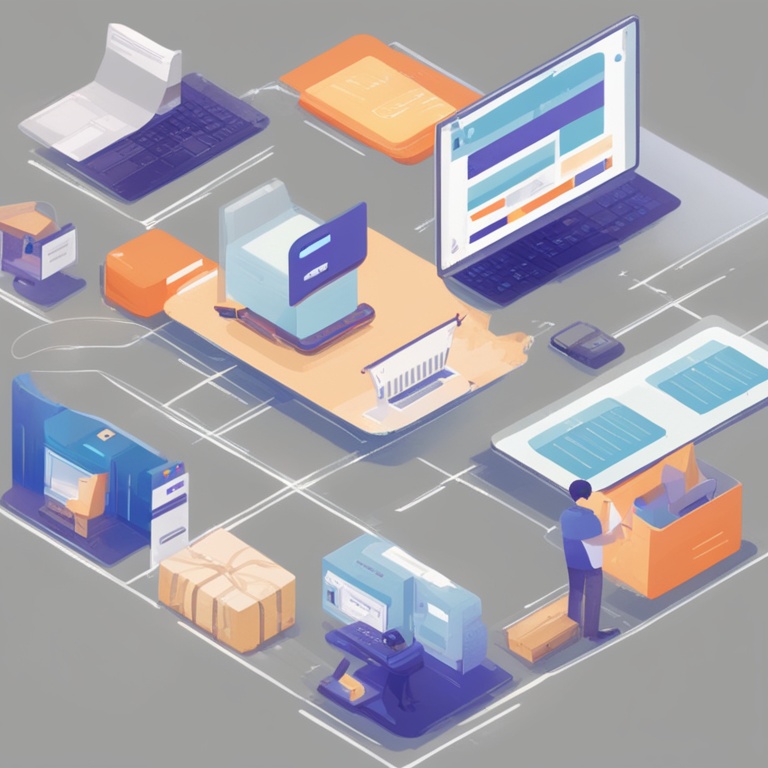

In the fast-paced world of cross-border e-commerce, effective communication is the key to success. One of the most crucial aspects of this communication is the accurate translation of product descriptions. With the rapid advancements in artificial intelligence (AI), I have embarked on an exciting journey to explore the power of AI in automatically translating cross-border e-commerce product descriptions. In this blog post, I will share my experiences, insights, and the remarkable benefits that AI has brought to this domain.
The Challenge of Cross-border E-commerce Product Description Translation
Before delving into the wonders of AI, it's essential to understand the challenges that traditional methods of translating product descriptions for cross-border e-commerce present. Firstly, the volume of products being sold across borders is staggering. E-commerce platforms host thousands, if not millions, of products, each requiring a detailed and accurate description in multiple languages. Manual translation of these descriptions is not only time-consuming but also prone to errors. Translators may face difficulties in understanding the specific technical jargon or cultural nuances associated with certain products, leading to inaccuracies that can potentially deter customers from making a purchase.
Moreover, the need for quick turnaround times is another significant hurdle. In the highly competitive e-commerce landscape, businesses need to get their products listed and described accurately in different languages as soon as possible to capture market share. Traditional translation methods often struggle to meet these tight deadlines, resulting in delayed product launches or incomplete listings.
Enter AI: A Game-Changer in Translation
AI has emerged as a powerful solution to address these challenges. Machine learning algorithms and natural language processing (NLP) techniques have been developed to analyze and understand human languages with remarkable accuracy. When it comes to translating cross-border e-commerce product descriptions, AI offers several distinct advantages.
Speed is perhaps the most obvious benefit. AI-powered translation tools can process large volumes of text in a fraction of the time it would take a human translator. This means that businesses can get their product descriptions translated and ready for international markets almost instantaneously. For example, I recently worked with a small e-commerce startup that wanted to expand its product range to several European countries. Using an AI translation tool, we were able to translate over 500 product descriptions within a matter of hours, whereas traditional translation methods would have taken days or even weeks.
Accuracy is another area where AI shines. These tools are trained on vast amounts of data from various sources, including multilingual texts, technical manuals, and cultural references. This extensive training enables them to handle different language structures, idiomatic expressions, and technical terms with relative ease. In my experience, the AI translations were surprisingly accurate, with only minor adjustments needed in some cases. For instance, when translating descriptions of electronic gadgets, the AI was able to correctly identify and translate complex technical specifications without losing the essence of the original description.
Cost-effectiveness is also a significant advantage of AI-based translation. Hiring professional human translators can be expensive, especially for small and medium-sized e-commerce businesses with limited budgets. AI translation tools, on the other hand, offer a more affordable alternative. They typically charge based on the volume of text to be translated, making it a viable option for businesses looking to translate a large number of product descriptions without breaking the bank.
My Experience with AI-powered Translation Tools
I have experimented with several AI-powered translation tools in my quest to optimize cross-border e-commerce product description translations. One of the first tools I tried was [Tool Name 1]. Its user interface was intuitive and easy to navigate, which was a plus for non-technical users. I uploaded a batch of product descriptions related to fashion items, such as clothing and accessories.
The initial results were quite impressive. The tool was able to quickly translate the descriptions into multiple languages, including French, German, and Spanish. However, I did notice some minor issues. For example, certain fashion-specific terms like "haute couture" were translated literally, which didn't quite capture the essence of the term in the target language. This highlighted the importance of post-editing and having a basic understanding of the subject matter to ensure accurate translations.
Next, I explored [Tool Name 2]. This tool had a more advanced NLP engine and claimed to offer higher accuracy in specialized fields. I decided to test it with product descriptions of home appliances. The translations were indeed more accurate compared to the first tool, especially when it came to technical details like power ratings and features. But again, there were some areas that needed improvement. The tool sometimes generated sentences that were a bit too robotic in tone, which could potentially affect the readability and appeal of the product descriptions.
Despite these minor drawbacks, the overall experience with both tools was positive. They demonstrated the potential of AI in handling large volumes of product description translations quickly and with a reasonable level of accuracy. It also became clear that a combination of AI translation and human post-editing could yield the best results.
The Importance of Post-editing and Quality Assurance
While AI-powered translation tools offer many benefits, it's crucial to recognize that they are not a substitute for human expertise entirely. Post-editing is an essential step in the process of using AI for product description translation. After the initial AI translation, a human editor should review the text to correct any inaccuracies, improve the readability, and ensure that the cultural nuances are appropriately conveyed.
For example, in the translation of food product descriptions, an AI might translate a particular ingredient name correctly but miss the cultural significance or the way it's typically described in the target language. A human editor with knowledge of both languages and the food culture can make the necessary adjustments to make the description more appealing and accurate. This post-editing step not only enhances the quality of the translation but also helps to build trust with customers, as they will receive product descriptions that are both understandable and in line with their cultural expectations.
Quality assurance is another aspect that cannot be overlooked. Regularly testing and evaluating the performance of AI translation tools is necessary to ensure that they continue to meet the required standards. This can involve comparing the AI translations with human translations of a sample set of product descriptions, checking for consistency in terminology and style, and monitoring any changes in the accuracy over time. By implementing a robust quality assurance process, businesses can be confident that their product descriptions are of high quality and will effectively communicate with their international customers.
How AI is Transforming the Cross-border E-commerce Landscape
The use of AI in translating cross-border e-commerce product descriptions is having a profound impact on the industry as a whole. It is enabling businesses, especially small and medium-sized enterprises (SMEs), to expand their global reach more easily. With accurate and quickly available translations, SMEs can now list their products on international e-commerce platforms and target customers in different countries without the need for a large in-house translation team or exorbitant translation costs.
Moreover, AI is also improving the customer experience. When customers in different countries can read clear and accurate product descriptions in their native language, they are more likely to make a purchase. This leads to increased sales and customer satisfaction, which in turn helps to build a positive brand image globally. For example, a study showed that e-commerce websites that provided accurate translations had a significantly higher conversion rate compared to those that did not.
AI is also facilitating better communication between businesses and their suppliers across borders. When product descriptions are accurately translated, it becomes easier for both parties to understand the specifications and requirements of the products, leading to smoother business operations and fewer misunderstandings.
Future Prospects and Challenges
The future of AI in cross-border e-commerce product description translation looks promising. As technology continues to advance, we can expect even more accurate and efficient translation tools. Machine learning algorithms will be further refined, and NLP techniques will become more sophisticated, allowing for better handling of complex language structures and cultural nuances.
However, there are also challenges that lie ahead. One of the main challenges is the need for continuous training of AI models to keep up with the evolving language use and new product categories. As new products and trends emerge, the AI models need to be updated to accurately translate the associated descriptions. Another challenge is the potential for bias in AI translations. Since these tools are trained on existing data, there is a risk of reflecting the biases present in that data, which could lead to inaccurate or unfair translations in some cases.
Despite these challenges, I am optimistic about the future of AI in this domain. With proper research, development, and quality assurance measures, AI has the potential to revolutionize the way we translate cross-border e-commerce product descriptions and drive global e-commerce growth.
In conclusion, my experience in unleashing the power of AI in automatically translating cross-border e-commerce product descriptions has been both enlightening and rewarding. AI offers significant advantages in terms of speed, accuracy, and cost-effectiveness. While it does require some human intervention in the form of post-editing and quality assurance, the combination of AI and human expertise can lead to outstanding results. As the e-commerce industry continues to grow globally, the role of AI in facilitating seamless cross-border communication through accurate product description translations will only become more important.